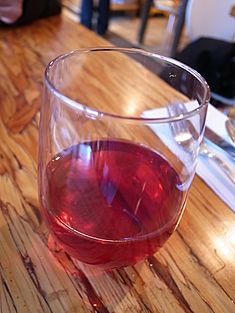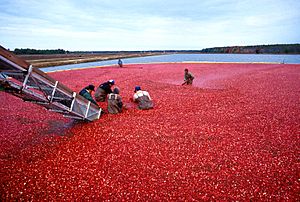Cranberry juice facts for kids
 |
|
| Nutritional value per 248 g (1 cup) | |
|---|---|
| Energy | 449 kJ (107 kcal) |
|
26.2
|
|
| Sugars | 23.5 |
| Dietary fiber | 0.2 |
|
0.29
|
|
| Saturated | 0.005 |
| Monounsaturated | 0.005 |
| Polyunsaturated | 0.005 |
|
Protein
|
0.65
|
| Vitamins | Quantity
%DV†
|
| Vitamin A equiv.
lutein zeaxanthin
|
163 μg
|
| Vitamin A | 60 IU |
| Thiamine (B1) |
1%
0.012 mg |
| Riboflavin (B2) |
3%
0.036 mg |
| Niacin (B3) |
1%
0.226 mg |
| Vitamin B6 |
3%
0.043 mg |
| Folate (B9) |
11%
43.2 μg |
| Vitamin B12 |
0%
0 μg |
| Choline |
1%
4.3 mg |
| Vitamin C |
91%
75.6 mg |
| Vitamin D |
0%
0 μg |
| Vitamin D |
0%
0.0 IU |
| Vitamin E |
0%
0.02 mg |
| Vitamin K |
0%
0 μg |
| Minerals | Quantity
%DV†
|
| Calcium |
5%
46 mg |
| Iron |
1%
0.19 mg |
| Magnesium |
3%
12 mg |
| Manganese |
8%
0.16 mg |
| Phosphorus |
3%
19 mg |
| Potassium |
6%
182 mg |
| Selenium |
0%
0.24 μg |
| Sodium |
1%
14 mg |
| Zinc |
1%
0.12 mg |
| Other constituents | Quantity |
| Water | 213 |
|
Link to USDA Database entry
|
|
| †Percentages estimated using US recommendations for adults. | |
Cranberry juice is a popular drink made from the juice of cranberry fruits. Cranberries are bright red berries that grow in North America. They have a very tart (sour) taste. Because of this, cranberry juice usually has sugar, water, and other fruit juices added to make it taste better.
Besides juice, cranberries are used to make many other products. These include dried cranberries, cranberry sauce, and even powders or dietary supplements. When you see "cranberry juice cocktail" or "cranberry juice blend," it means the drink is mostly water and other fruit juices, with about 28% cranberry juice. Sweeteners are added to make it less tart.
For a long time, people thought cranberry juice could help fight urinary tract infections (UTIs). However, studies have shown that there is no clear proof that cranberry juice can prevent or treat these infections.
Contents
What's in Cranberry Juice?
Cranberry juice is mostly water, about 86% of it! It has some carbohydrates (sugars) and very little fat or protein.
A typical cup (about 248 grams) of cranberry juice has around 107 calories. It often contains vitamin C to keep it fresh. While vitamin C and folate are present in good amounts, cranberry juice doesn't provide many other important micronutrients.
A half cup of cranberry juice has about 60 calories. It gives you 20% of the Daily Value for vitamin C. In the United States, this counts as half a fruit serving towards your daily nutrition goals.
How Cranberry Juice is Made
Cranberries used for juice come from a plant called the "American cranberry." This plant is grown on farms, especially in Canadian provinces like British Columbia and Quebec.
Harvesting Cranberries
Cranberries are often harvested using a method called "wet harvesting." This is a cool process! Farmers flood the cranberry fields with water. Then, a special machine with paddles stirs the water, which makes the ripe cranberries float to the surface. The floating berries are then collected and taken to a processing plant.
Making the Juice
At the plant, the cranberries are crushed. Then, they are heated and pressed to get the juice out. This juice is then turned into a concentrated form, which means most of the water is removed. To make cranberry juice for drinking, this concentrate is mixed with water again, along with other ingredients.
Keeping it Safe
To make sure cranberry juice is safe to drink, it goes through a process called pasteurization. This involves heating the juice to kill any harmful germs. This heat treatment also helps the juice last longer.
Newer ways to make juice safe include high pressure processing (HHP) and pulsed electric field (PEF) technology. These methods use pressure or electricity instead of heat. They can help keep the juice's natural flavor, color, and smell.
Why Additives?
Cranberries are naturally very sour and don't have much sugar. So, unsweetened cranberry juice can taste quite strong. To make it taste better for most people, other fruit juices, sugar, or sugar substitutes are often added.
Packaging Juice
Cranberry juice is usually put into sealed containers like plastic bottles, cans, or cartons. These containers keep the juice fresh and safe. Large brands like Ocean Spray sell cranberry juice that can last for a long time, even when frozen.
Rules for Cranberry Juice
Governments have rules about how cranberry juice is made and what goes on its labels.
What Labels Say
In the United States, the Food and Drug Administration (FDA) allows a special message on cranberry juice labels. It says that drinking one serving (8 ounces) of cranberry juice each day *may* help reduce the risk of repeated urinary tract infections in healthy women. However, the FDA also says that the scientific evidence for this is "limited and inconsistent."
Cranberry juice labels also show important information like the product name, nutrition facts, and where it was made. In Canada, if a juice says "no preservatives," it means it only has natural things that help keep it fresh.
Rules in the United States
In the US, cranberry juice from concentrate is a mix of cranberry juice (or concentrate), water, sweeteners, and vitamin C. The cranberries used must be clean, ripe, and well-colored. Different amounts of sugar or corn syrup can be added. The rules also say how much cranberry juice must be in the mix and how much vitamin C it needs.
Rules in Canada
In Canada, cranberry juice is also regulated. It must be made from clean, ripe cranberries. Sugar or other sweeteners can be added. If a drink is called "cranberry juice drink" or "cooler," it must have at least 25% cranberry juice.
Cranberries in Canada are sorted into grades like "Canada No. 1" and "Canada Domestic." These grades ensure the berries are clean, uniform in size, and free from damage. They also need to be at least 65% red in color.
Cranberry Juice in the Market
Cranberries are grown and harvested in the autumn in the United States and Canada. Most of the cranberries grown in the US (about 95%) are used to make juice or juice blends.
Wisconsin is a top producer of cranberries in the United States. Millions of pounds of cranberries are eaten by Americans every year, mostly in the form of juice!
See also
 In Spanish: Jugo de arándano para niños
In Spanish: Jugo de arándano para niños


